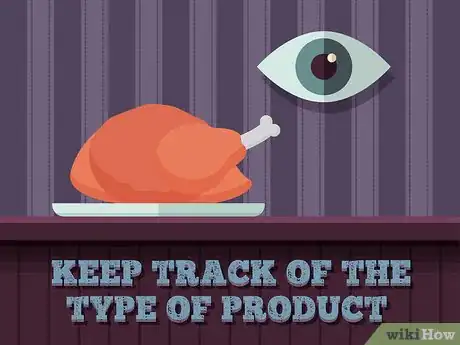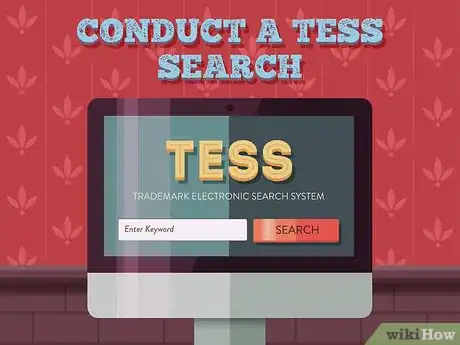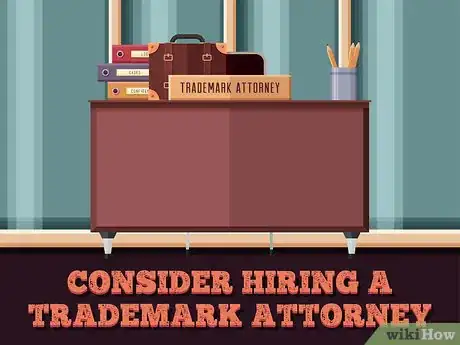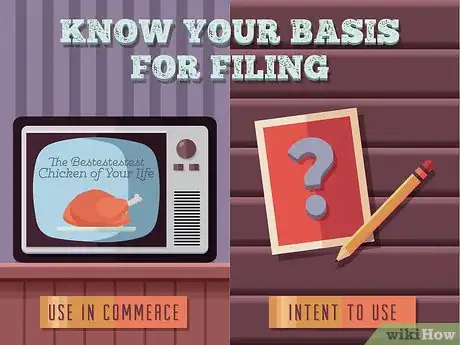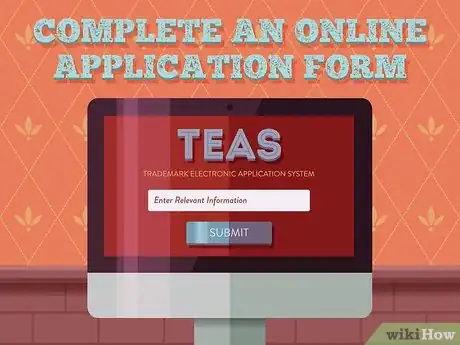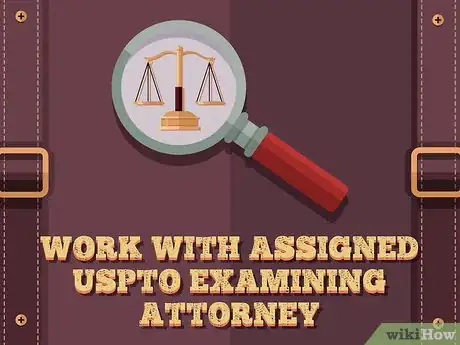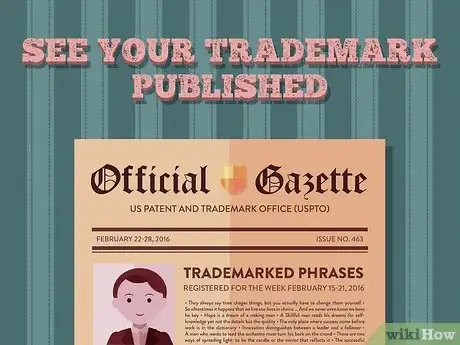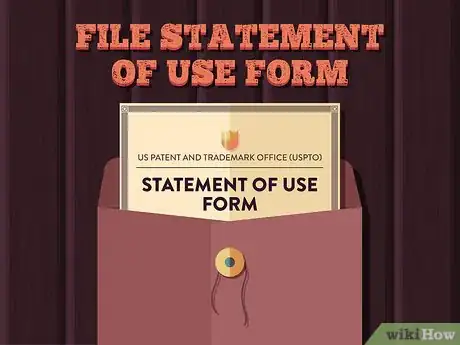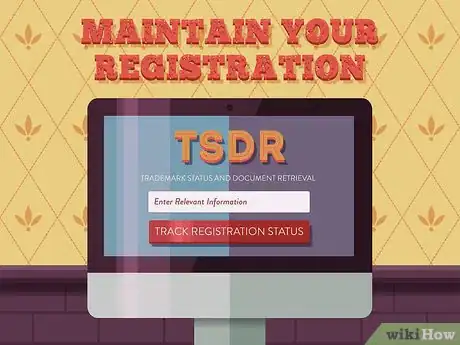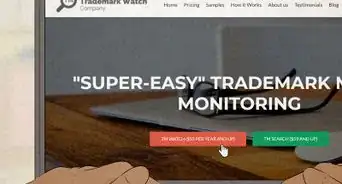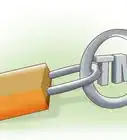This article was co-authored by Clinton M. Sandvick, JD, PhD. Clinton M. Sandvick worked as a civil litigator in California for over 7 years. He received his JD from the University of Wisconsin-Madison in 1998 and his PhD in American History from the University of Oregon in 2013.
wikiHow marks an article as reader-approved once it receives enough positive feedback. In this case, 100% of readers who voted found the article helpful, earning it our reader-approved status.
This article has been viewed 98,045 times.
Trademarks are symbols, words, or combinations of words that are used to represent a product or a service. Registering a trademark allows the person who registered it to control how the “mark” is used, protect their brand, and prohibit others from using the mark to sell their own products. If you have a unique phrase or slogan for a business, you will want to trademark it to protect its usage.
Steps
Searching for a Phrase
-
1Create your phrase. You can't trademark a phrase that doesn't exist. Know the brand or idea you are trying to promote. Keep your slogan short, memorable, and appropriate for your audience.
- The most valuable trademarks are those with inherent distinctiveness, such as newly made up words or the use of words not normally associated with each other, such as "APPLE COMPUTER".
- You can use a common word or phrase, but be aware that to obtain a trademark, you need to show that the phrase has a “secondary meaning” that makes your use different from the usual meaning of the phrase. You will also need to show how that secondary meaning is connected with your product or service.
- You should also be able to describe the representation, or how your phrase will look. If you want to add any specific design element to your slogan, that becomes part of the trademark.[1] A combination mark may be more restrictive when your needs change over time.
-
2Generate search terms. Using your phrase, generate a list of trademark search terms. Choose search terms that match your phrase exactly, but also use those that are similar in appearance, sound or meaning. For example, if your phrase is “The Bestestestest Chicken of Your Life,” you may choose search terms that vary the spelling of the word ‘best’ or that add words to the beginning or end of the phrase, like “We Serve the Best Chicken of Your Life.” You might also search for things similar to chicken, such as "rooster" or "fowl" or "hens".
- Keep in mind that the goal of the search is to determine whether the phrase that you wish to trademark, or anything very similar to that phrase, is already being used, especially in any related field.
Advertisement -
3Type your search into a search engine. Repeat this for each of your search terms and take note of the results of each of your search terms. Pay special attention to those results that are very similar or identical to your phrase. You may wish to print out your results to keep track of any similar marks.
- Use several different search engines (Ask, Bing, Google, Yahoo) to make sure you cover what is out there as fully as possible. They will probably give similar results, but it's best to be thorough in your search.
-
4Keep track of the type of product or service that your search results represent. Note any mark that is similar to the way that you intend to use your phrase and represents a similar product or service to your company. For example, if your phrase is “The Bestestestest Chicken of Your Life,” and you use the phrase in conjunction with a fried chicken restaurant, take note of any restaurant or food services company using a similar phrase.
- You might also search for domain names with your words in them and search trade journal articles related to your industry.
-
5Conduct a Trademark Electronic Search System (“TESS”) search. Search for similar terms just as you did in other search engines. Take notes of your searches in TESS as you did in the previous step. TESS uses the US Patent and Trademark Office's (USPTO) searchable, online database of applications and registered trademarks to see if anyone has registered your phrase or has attempted to. TESS is available through the USPTO’s website ([1]).
- Pay particular attention to any applications that were denied involving variations on your proposed brand. They may indicate that others already had trouble for some reason.
-
6Consider hiring a Trademark Attorney. If your searching finds someone else using a phrase similar to yours, and you still want to use the phrase yourself, a trademark attorney can help you with the rest of the process. If you find no other company using your name as their own mark, you may still want to hire a trademark attorney to ensure that your search was accurate and sufficiently complete.
- Decide whether to register your brand in one or more US states or to not register it at all, giving you only limited protection of your brand against infringement by others.
Filing a Federal Trademark Application
-
1Know your basis for filing. The USPTO will ask what you intend to use the phrase for, and when you intend to start using it. Depending on the answer, your basis will either be "use in commerce" or "intent to use."[2]
- "Use in commerce" basis involves slogans already in use on goods or services. You will need to provide the approximate date that you began using the phrase and a clear example of you using of the phrase on the goods or services you are registering.
- "Intent to use" basis is for phrases that you intend to use in the future, but have not yet used. This basis requires an additional form and fee before registering.
-
2Consider the ownership carefully. If you file in the name of someone who is not actually using the brand or who does not have the "intent to use", your application may be deemed void and you'll have to start over.
- You cannot transfer ownership of an "intent to use" application.
-
3Describe the goods or services to which the brand will apply. The USPTO has a manual of acceptable identification of goods or services that will also assist you in identifying the classifications in which you want registration.
- A separate filing fee or application is required for each classification. For example, making computers is class 9, computer books are class 16, and programming computers services is class 42.
- You may be allowed to amend your goods and services descriptions later, but only to narrow and refine them.
- Your specimen of use must show the brand in use on goods or services in each class for which you request registration.
-
4Complete an online application form. Use the USPTO's Trademark Electronic Application System (TEAS). There are three different forms, the TEAS Regular, TEAS Plus, and TEAS RF (Reduced Fee).[3]
- TEAS Plus applicants agree to file additional forms, which will ask about identification taken from the USPTO Trademark ID Manual, additional mark-related information, and a valid e-mail address for correspondence.
- TEAS RF applicants agree to file additional forms and provide a valid e-mail for correspondence. If you file a TEAS RF application, but fail to meet the requirements, you will have to submit an additional $50 processing fee.
- The USPTO website (http://www.uspto.gov/trademarks-application-process/filing-online/initial-application-forms) has sample PDFs to view. You should look at these before filing to make sure you have all the proper information. You cannot submit these PDFs, they are for reference only.
- Pay the filing fee. The filing fee will be $225 (TEAS RF), $275 (TEAS Plus), or $325 (TEAS Regular) depending on the form you file. This fee is non-refundable.
- Be sure to spell all parts of the phrase exactly as you intend to use the phrase. The examining attorney that reviews your application to determine if it is valid will look at all similar brands, but will only allow you to register the one you submit.
- Make a copy of all of your materials before you submit them and retain it for your records.
- You will need to file a separate form for each individual phrase you wish to trademark.
-
5Work with assigned USPTO examining attorney. Once you have met all the filing requirements, your application will get a serial number and be assigned to an examining attorney. The attorney will review your phrase to make sure it complies with all applicable laws, and search for conflicting marks.[4]
- Assuming your brand is not "illegal" for registration, the standard for distinctiveness is whether your brand creates a "likelihood of confusion" with any other brands currently registered in the USPTO, which can be highly subjective.
- If there is a change to your application, the attorney will send written confirmation, called an "examiners amendment." Unless you disagree with the change, you don't need to respond.
- If there are issues with your application, the examiner will send you a letter, either a priority action or office action. This letter should explain the issue and what you can do to resolve it. You may be given up to 6 months to respond to a priority or office action.
- For any of these letters, the USPTO recommends filing a response electronically through their website: http://www.uspto.gov/trademarks/teas/response_forms.jsp.
- In some cases the examiners can be persuaded to withdraw an objection if you narrow your goods or services to avoid possible overlap in areas already occupied by others. In other cases they will simply refuse registration due to one or more legal considerations.
-
6See your trademark published. Once the attorney has no objections, or you resolve all issues, your phrase will be published in the "Official Gazette," a weekly publication from the USPTO. At this point, anyone who wants to challenge your phrase has 30 days to do so. If they don't, or their opposition fails, you can move on to the next stage.
- Any challenge will be heard by the Trademark Trial and Appeal Board, a part of the USPTO. An opposition is very much like a court litigation and may take years and cost thousands of dollars. Many applicants choose to abandon the application and start over with something else. This is why you need to pay close attention to WHY any similar applications were already rejected.
-
7File statement of use form. Once your phrase gets past any challenges, the USPTO will send you a notice of allowance. If you had filed with "intent to use", and have not yet amended your application for "actual use", you will have 6 months to file a statement of use form and fees, or to request a 6 month extension (up to 36 months), with more fees. From there, the USPTO will review your form, and issue letters as during the initial review.
- Once your application is approved, the USPTO will issue you a registration. Congratulations, you have a registered trademark on your phrase!
- You should begin using the circle-R ® mark on your brand when used on the goods or services listed in your registration.
-
8Maintain your registration. You must file additional documents to keep your registration current.[5] If your registration lapses at any point, you will need to repeat the application process, so keep an eye on it.
- Check the USPTO's Trademark Status and Document Retrieval (TSDR) system to track your registration status. The system is available through their website: http://tsdr.uspto.gov/
- The USPTO says that you should make any necessary filings between the fifth and sixth year, and the ninth and tenth year following registration.[6]
-
9Enforce and protect your registration. The USPTO will try to prevent others from registering a brand similar to yours as long as you maintain your registration. However, you have the obligation to patrol your industry and make sure nobody else is violating your trademark rights or misusing your brand.
- If you stop using your brand for several years, without a valid business reason, you may lose your legal right to enforce it, even if the registration has not expired.
- Anyone can still challenge your registration if they had previous rights of priority and your use will create a likelihood of confusion, or if your registration was issued in violation of the law.
- The Washington Redskins had their 1967 registrations cancelled in 1999 after the TTAB heard complaints that they were "disparaging", in violation of the federal law, although they had been in use since 1933. The US Supreme Court eventually ruled that the law was unconstitutional and the registrations were reinstated.
Warnings
- This process is not confidential. The USPTO is a government organization, so everything you submit during the application process is part of the public record. This is true even if you withdraw the application, or your application is rejected.⧼thumbs_response⧽
- Once your phrase is trademarked, you are responsible for making sure no one else uses it.⧼thumbs_response⧽
References
- ↑ http://www.uspto.gov/trademarks-getting-started/trademark-basics/representation-mark
- ↑ http://www.uspto.gov/trademarks-getting-started/trademark-basics/basis-filing
- ↑ http://www.uspto.gov/trademarks-application-process/filing-online/reduced-fees-teas-application-filing-options
- ↑ http://www.uspto.gov/trademarks-maintaining-trademark-registration/responding-office-actions
- ↑ http://www.uspto.gov/trademarks-application-process/filing-online/registration-maintenancerenewalcorrection-forms
- ↑ http://www.uspto.gov/trademarks-getting-started/trademark-process#step6
About This Article
If you want to trademark a phrase, visit the website of the US Patent and Trademark Office, or USPTO. Find the Trademark Electronic Application System, or TEAS, and choose the form that applies to you. Include a description of the goods or services the phrase will be used to describe, and pay the filing fee when you send in your application. Once your application has been filed, it will be assigned to an examining attorney, and then it will be published so anyone who disputes your right to the phrase can come forward. If no issues arise, your trademark will be granted! Keep reading for tips from our Litigation co-author on how to make sure no one else has already used your phrase!



